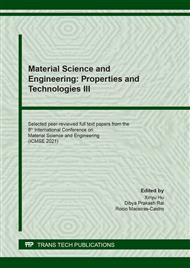[1]
C. Hepburn, E. Adlen and J. Beddington. The technological and economic prospects for CO2 utilization and removal. Nature. Vol 575, 87-97 (2019).
DOI: 10.1038/s41586-019-1681-6
Google Scholar
[2]
Z. Jiang, X. H. Xu and Y. H. Ma. Filling metal–organic framework mesopores with TiO2 for CO2 photoreduction. Nature. Vol 586, 549-586 (2020).
DOI: 10.1038/s41586-020-2738-2
Google Scholar
[3]
W. C. Ma, S. J. Xie and X.-G. Zhang. Promoting electrocatalytic CO2 reduction to formate via sulfur-boosting water activation on indium surfaces. Nature Communication. 10, 892 (2019).
DOI: 10.1038/s41467-019-08805-x
Google Scholar
[4]
S. Gao, Y. Lin and X. C. Jiao. Partially oxidized atomic cobalt layers for carbon dioxide electroreduction to liquid fuel. Nature. Vol 529, 68-82 (2016).
DOI: 10.1038/nature16455
Google Scholar
[5]
Q. Lu, J. Rosen and Y. Zhou. A selective and efficient electrocatalyst for carbon dioxide reduction. Nature Communication. 5, 3242 (2014).
Google Scholar
[6]
D. H. Won, H. Shin and J. Koh. Highly Efficient, Selective, and Stable CO2 Electroreduction on a Hexagonal Zn Catalyst. Angew. Chem. Int. Ed. 55, 9297-9300 (2016).
DOI: 10.1002/anie.201602888
Google Scholar
[7]
Q. G. Zhu, J. Ma and X. C. Kang. Efficient Reduction of CO2 into Formic Acid on a Lead or Tin Electrode using an Ionic Liquid Catholyte Mixture. Angew. Chem. Int. Ed. 55, 9012-9016 (2016).
DOI: 10.1002/anie.201601974
Google Scholar
[8]
X. Q. Min, M. W. Kanan. Pd-Catalyzed Electrohydrogenation of Carbon Dioxide to Formate: High Mass Activity at Low Overpotential and Identification of the Deactivation Pathway. J. Am. Chem. Soc. 137, 4701-4708 (2015).
DOI: 10.1021/ja511890h
Google Scholar
[9]
A. Klinkova, P. D. Luna and C.-T. Dinh. Rational Design of Efficient Palladium Catalysts for Electroreduction of Carbon Dioxide to Formate. ACS Catal. 6, 8115-8120 (2016).
DOI: 10.1021/acscatal.6b01719
Google Scholar
[10]
D. F. Gao, H. Zhou and F. Cai. Switchable CO2 electroreduction via engineering active phases of Pd nanoparticles. Nano Research. Vol 10, 2181-2191 (2017).
DOI: 10.1007/s12274-017-1514-6
Google Scholar
[11]
W. L. Zhu, S. Kattel and F. Jiao. Shape-Controlled CO2 Electrochemical Reduction on Nanosized Pd Hydride Cubes and Octahedra. Adv. Energy Mater. 9, 1802840 (2019).
DOI: 10.1002/aenm.201802840
Google Scholar
[12]
T. Chen, S. Chen and Y. W. Zhang. Catalytic Kinetics of Different Types of Surface Atoms on Shaped Pd Nanocrystals. Angew. Chem. Int. Ed. 55, 1839-1843 (2016).
DOI: 10.1002/anie.201509165
Google Scholar
[13]
M. S. Jin, H. Zhang and Z. X. Xie. Palladium nanocrystals enclosed by {100} and {111} facets in controlled proportions and their catalytic activities for formic acid oxidation. Energy Environ. Sci. 5, 6352-6357 (2012).
DOI: 10.1039/c2ee02866b
Google Scholar
[14]
Y. Wang, J. C. Kim and R. J. Wu. Van der Waals contacts between three-dimensional metals and two-dimensional semiconductors. Nature. Vol 568, 70-74 (2019).
DOI: 10.1038/s41586-019-1052-3
Google Scholar
[15]
G. Kresse, J. Furthmuller. Efficiency of ab-initio total energy calculations for metals and semiconductors using a plane-wave basis set. Computational Materials Science. 6, 15-50 (1996).
DOI: 10.1016/0927-0256(96)00008-0
Google Scholar
[16]
J. P. Perdew, K. Burke and M. Ernzerhof. Generalized Gradient Approximation Made Simple. Physical Review Letters. Vol 78, 1396 (1997).
DOI: 10.1103/physrevlett.78.1396
Google Scholar
[17]
H. Xie, T. Y. Wang and J. S. Liang. Cu-based nanocatalysts for electrochemical reduction of CO2. Nano Today. 21, 41-54 (2018).
DOI: 10.1016/j.nantod.2018.05.001
Google Scholar
[18]
J. L. Sheng, J. H. Kang and H. Q. Ye. Porous octahedral PdCu nanocages as highly efficient electrocatalysts for the methanol oxidation reaction. J. Mater. Chem. A. 6, 3906-3912 (2018).
DOI: 10.1039/c7ta07879j
Google Scholar
[19]
M. S. Jin, H. Y. Liu and H. Zhang. Synthesis of Pd Nanocrystals Enclosed by {100} Facets and with Sizes <10 nm for Application in CO Oxidation. Nano Res. 4(1), 83-91 (2011).
DOI: 10.1007/s12274-010-0051-3
Google Scholar
[20]
S. Nitopi, E. Bertheussen and S. B. Scott. Progress and Perspectives of Electrochemical CO2 Reduction on Copper in Aqueous Electrolyte. Chem. Rev. 119, 7610-7672 (2019).
DOI: 10.1021/acs.chemrev.8b00705
Google Scholar


